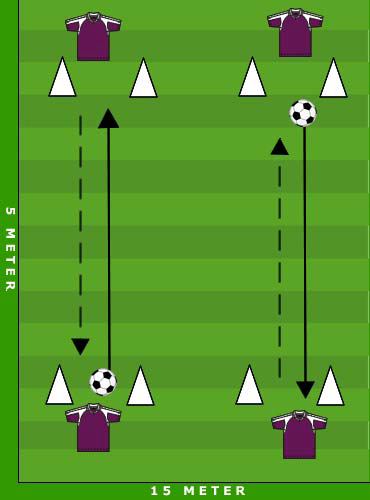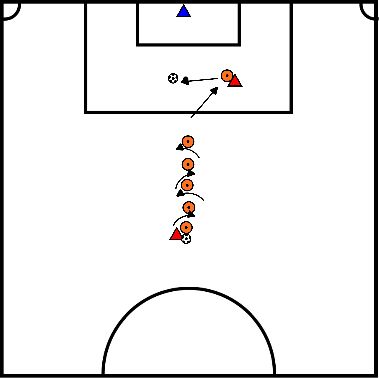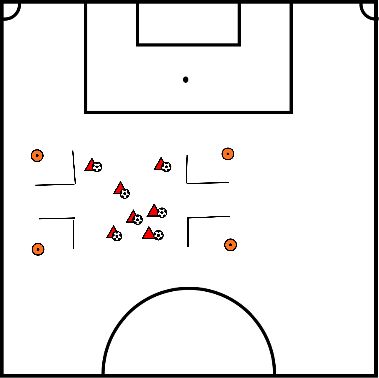Soccer drills
In King Football, the players learn to pass well.
- 2 teams
- Per team 1 King
- 1 ball per team. (variation 1 ball if a game is played)
- The teams move in the field in a square.
- The intention is that the ball is played over 3 times within your own team and then shot to the King.
- When the King takes it, there is a point for that team.
- First, they practise within the team and then they play against each other.
- When the ball is taken away, it has to be counted again.

Field setup:
Set up 2 x 2 pawns per group of 2 players. Every 2 players get 1 ball.
Gameplay:
The ball is thrown up by one player and kicked back by the other. The following variants must be practised.
Variants:
- Head the ball back into the hands of the player.
- Head the ball over the player.
- Head the ball through the ground towards the player.
Tips:
- Make sure you head from your neck and don't just let the ball bounce on your head.
- Always tighten your arm muscles and move your head towards the ball.
- Player 1 starts dribbling along 5 hats
- Then plays player 2 who waits by hat
- Player 2 bounces the ball back on player 1
- Player 1 finishes.
- Player 2 fetches ball and joins the back of the line
- Player 1 runs to the pylon to bounce the ball back

- Dribble in large square
- Make small squares on the outside corners
- Name the small squares
- When calling the name, everyone must dribble to that square
- Eventually you can work with a knockout system, so that the last 2 get eliminated.

2 teams
- The players have to play football 4 against 2 and must have replayed at least 3 times in the attack and a maximum of 10 times before scoring.
- When a ball is taken off/ touched/ crosses the line or a score is scored, there must be a switch between attacking and defending.
- When there is no overplay, no scoring is allowed.
- Walk over the field in 2 numbers.
- Both players hold one end of a rope (1.5 meters).
- Once the attacker determines the pace and direction.
- As soon as the rope is released when it comes to tension, the attacker has a point.
- Defender may only hold the rope loosely.
- All players jog in over the field (square)
- Half the number of players has a ball
- players with ball pass the ball to a player without ball (eye contact).
- The players are not allowed to keep the ball with them for longer than 5 sec.
- At the moment the trainer whistles (signal), all players without a ball sprint as fast as possible to the closest player who has a ball and try to take it away.
- The player who has the ball should try to fence it off. (1:1 duel)
- When the trainer blows the whistle again we switch back to jogging and passing!
Nice variant is when you have an odd number of players, the player who can't find a direct opponent gets a command (for example sprint over the width of the field).
- The players line up in a circle,
- Ideal is 6 to 8 players per circle.
- Per circle you only have one ball.
EXECUTION:
- A player plays the ball to another player, chasing the ball towards the player he is playing.
- The second player receives the ball and plays it back to another player in the circle,
- He, too, will chase the ball towards the player he has just played in.
- This keeps repeating itself.
QUALITY:
- Passes must be clear and accurate.
- The passes are played over the ground, keep the ball low!
- Just after the pass the players accelerate (short sprint)
- Players call the name of the player they want to play in
- All players constantly stand on their toes, not on flat feet, to improve the speed of action.
PROGRESS:
- You can make the game more difficult by hitting once.
- You can play with two balls
- Player 1, who has given the pass, should try to tap the player who has played the pass (player 2) before playing the ball to player 3, etc.
Exercise1 RUN STRAIGHT FORWARD
- Jog to the last pylon.
- Make sure your upper body is upright.
- Your hips, knees and feet should form a line.
- Don't let your knees buckle inwards.
- On the way back, run a little faster.
- Do the exercise twice.
Exercise 2 RAISE KNEE AND TURN UPPER LEG OUTWARDS WHILE RUNNING
- Jog to the first pylon.
- Stop and raise your knee forward.
- Turn your knee out and put your foot down.
- Keep your pelvis horizontal and your upper body still.
- The hip, knee and foot of the supporting leg together form a straight line.
- Do not let the knee of the supporting leg bend inwards.
- Jog to the next pylon and repeat the exercise with the other leg.
- When you have finished the course, jog back. Do the exercise twice.
Exercise 3 RAISE KNEE AND TURN UPPER LEG INWARDS WHILE RUNNING
- Jog to the first pylon.
- Stop and raise your knee sideways.
- Turn your knee inwards and put your foot down.
- Keep your pelvis horizontal and your upper body still.
- The hip, knee and foot of the supporting leg together form a straight line.
- Do not let the knee of the supporting leg bend inwards.
- Jog to the next pylon and repeat the exercise with the other leg.
- When you have finished the course, jog back.
- Do the exercise twice.
Exercise 4 RUNNING AROUND A PARTNER
- Jog to the first pylon.
- Shuffle sideways, at an angle of 90 degrees to your partner, shuffle a whole circle around each other (without changing your direction of view).
- and back to the first pylon.
- Bend your hips and knees slightly and move your body weight to the ball of your feet.
- Do not let your knees bend inwards.
- Jog to the next pylon and repeat the exercise.
- When you have finished the course, jog back.
- Do the exercise twice.
Exercise 5 JUMP AND TOUCH SHOULDERS WHEN RUNNING
- Jog to the first pylon.
- Shuffle sideways, at an angle of 90 degrees to your partner.
- Jump in the middle towards each other to make shoulder to shoulder contact.
- Land on both feet with your hips and knees bent.
- Do not let your knees bend inwards.
- Shuffle back to the first pylon.
- Jog to the next cap and repeat the exercise.
- When you are ready with the course, jog back.
- Do the exercise twice.
Exercise 6 RUN ACCELERATING AND SLOWING DOWN
- Run quickly to the second pylon
- and then run backwards to the first pylon;
- keep your hips and knees slightly bent.
- Always run two pylons forward and one back.
- When you're done with the course, jog back.
- Do the exercise twice.
Set up your team in 2 lines (4-5 per line max) - only 1 ball needed.
IMPLEMENTATION:
- Players take the ball and then play it to the first person in the line opposite to them. Immediately after the pass they draw a sprint and close the back of the line they just played in. This is repeated over and over again.
QUALITY:
- Players are all on their toes ready for the pass.
- Passes are clear and accurate.
- Players must shout if they want the ball to play, and also shout the name to whom they are passing again.
- With the first ball contact they bring the ball under control, the second ball contact is the pass to the other player.
PROGRESS:
- Apply only one pass.
- Let one line pick up the ball and throw it back to the other line. They will then play the ball back with a volleypass and then simply join the other line.
- Let players take the ball with their thigh and bring it under control after which they pass the ball back over the ground.
- Place a pawn 5 meters on either side of the central point between the 2 lines. After the pass, the players have to walk around the pawn after which they connect in the row.
- Split your team into four teams of four
- 1 ball per team
IMPLEMENTATION:
- Players play the ball around within their team of four in the area that was put out
QUALITY:
- Players are constantly moving, with many tempo changes to find space.
- Each team must try to maintain a diamond shape
- Players must all communicate with teammates, the ball must be asked for and the player's name must be called by the person who is playing the ball.
- Passes should arrive well, in space or in the feet.
- Players should not touch each other, nor should the balls touch each other.
- This exercise requires great vigilance on the part of the players.
PROGRESS:
- Add a passive defender who can defend any ball.
- Add a defender who can conquer the ball.
For this fun and interactive soccer warm up you let the players make a circle around you, about 15 meters away from you. So you are standing in the middle of the circle.
IMPLEMENTATION:
- The starting point of the players is their place in the circle, they stay "jogging" in place.
- Call: "Inside" and all players sprint towards you up to a meter or two away. Then they turn around and quickly sprint back to their spot where they keep moving.
- Call: "Outside" and all players sprint away from you until you call "Back", then everyone returns to the starting position in the circle.
QUALITY:
- Make sure players do not stand on their flat feet, but always on their toes.
- Players should sweat heavily after this exercise.
PREVENTION:
- You can apply different variations: sit-ups, push-ups, jump up, knees up by base position, sprint to the right or left while maintaining the circle shape.








